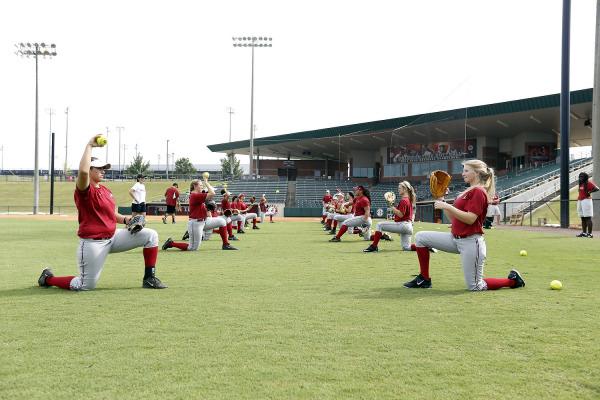Madi Moore isn’t going to have it easy when she scrimmages against her teammates on the Alabama softball team.
They will repay the favor done to them by pitchers like Jaclyn Traina, who led the team to a national title, and Alexis Osorio who battled three games to send the Crimson Tide back to Oklahoma City.
The lineup won’t take it easy on her because no one took it easy on them.
“You have to because those girls, when we go into real games, they’re not going to just, ‘Oh, she’s a freshman, let me take it easy on her,’” senior utility Leona Lafaele said.
Moore has a trick up her sleeve, one that she doesn’t consciously use. She’s a left-handed pitcher, and for many batters, that fact alone means she can’t be hit.
Before Moore, Alabama has had two lefties: Blair Potter and Charlotte Morgan.
Moore is a local kid, only about an hour from her home in Winfield, Alabama. She grew up coming to Alabama softball camps. She played for a travel team in Birmingham and faced teams from around the country with players headed off to play at Division I schools.
“What I want to see when I recruit a pitcher is her throwing against the girls that are going to the colleges that we need to beat,” head coach Patrick Murphy said.
As a senior in high school, Moore missed most of the season with an injury but returned in time for postseason play where she threw a no-hitter.
“Every time we’d go to watch her, she’d prove her worth,” Murphy said.
What makes a lefty so hard to hit is mostly mental. Many batters don’t see lefties all that often, even less so than in baseball.
It’s a change of pace for batters who often see right-handed pitchers in games and in batting practice from pitchers and coaches.
“I also think there’s a mental block sometimes with hitters for lefties,” Moore said. “I don’t really think many people think of it as that but I can see, just like hearing some batters in the past even on my team in the past, not here, just saying, ‘Oh, man, she’s a lefty. I can’t hit her.’ OK, well, you probably can. It’s just the fact that it’s just in your head so I think that’s very beneficial for lefty pitchers.”
A batter must adjust to the ball coming in from a different angle with different spin.
While a right-hander often has trouble jamming a lefty batter, the lefty pitcher can jam a right-handed batter easily.
“Most lefties, the hitters don’t see it going away from them hard and away,” Alabama pitching coach Stephanie VanBrakle said. “They’re usually seeing just a flat screwball from a righty that stays straight or maybe they try to come in hard, but it doesn’t really get in there with them so the angle of how the ball’s coming towards the batter is different.”
For junior Marisa Runyon, hitting against a lefty can be tricky. She bats from the left side and spent most of the 2015 NCAA Super Regional trying to figure out Oklahoma left-hander Paige Parker. She did, and sent the Crimson Tide to Oklahoma City with a two-out grand slam in a winner-take-all game three.
“It obviously is a different angle and being lefty-on-lefty, the same side, it is different, but I do think it’s still the same mentality as a righty pitcher, just kind of see the ball, hit the ball, you know, back to the basics,” Runyon said.
Having Moore will help the team get used to a lefty, but she hasn’t scrimmaged with them yet.
So far, she’s been eased back into pitching. She worked back to her first full bullpen two weeks ago after taking a month off this summer.
Moore will get her first taste of collegiate competition when Alabama heads to Middle Tennessee State for a doubleheader on Sunday.









